Best Practices for Generating AI Content: A Comprehensive Guide
Whether we like it or not, AI-generated content is booming. No surprise, the jackpot's here. According to the latest research, gen AI could add $2.6 to $4.4 tri...
Whether we like it or not, AI-generated content is booming. No surprise, the jackpot's here. According to the latest research, gen AI could add $2.6 to $4.4 trillion in value to the global economy. The only problem? While some of this content is top-notch, a lot of it is pure junk. 🤢
Don’t get us wrong. There is nothing wrong with using AI tools in your content creation process. But you need to be strategic about it. This article will guide you through AI content generation best practices and help you create content that's high quality and ethical. You know, just to keep heart in the art.
(well, that was awkward)

🎯 Step 1: Define the Purpose of Your Content
Rule number one for getting high-quality content out of LLMs?
You need to know what the hell you want to create.
Think of AI like any other tool in your toolbox. A woodworker wouldn’t let a table saw get creative and run unsupervised in a workshop. And you shouldn’t let AI go rogue with your content too.
(imagine the mess — splinters and chaos everywhere!)
So, before you type your first prompt, ask yourself the following questions:
💭 “What am I trying to create?”
💭 “Who am I creating this for?”
💭 “What tone and style should this content have?”
💭 “What should and shouldn’t be included?”
Once you have the groundwork in place (and only then), it’s time to do some research.
“Wait, isn’t this what AI is for?”
Well, yes and no. Large language models (LLMs) like GPT-4, Gemini, or LLama 2 have a knowledge cutoff date. Anything that happened after that date? The AI has no clue about it. But that’s not all.
All AI models can sometimes hallucinate, mixing real facts with totally made-up stuff. If the AI says something, you need to make sure the source is legit. Even if it grabs info from the web, you shouldn’t take it at face value. You need to dig deep to get to the original sources. Trust, but verify.
Finally, check the content for originality. While blunt plagiarism in AI-generated content is rare, it can happen, especially when AI is pulling information from external resources in real time.
So, do your own research, gather facts, dates, and references. Build up a large pool of reliable information. Learn as much as possible about the topic you’re covering. Once you’re done, you can feed the pieces to AI, either manually or using Retrieval Augmented Generation (we’ll get to that).
Now, you know what you want to create and who you create it for.
Let’s get our hands dirty and come up with the right prompts.
⌨️ Step 2: Crafting Effective Prompts
An AI prompt is a set of instructions or questions given to an AI model to elicit a specific response. A well-crafted prompt also helps AI understand the context of what you’re asking for.
For example, this is a prompt:
⌨️ “Write a friendly blog post about the benefits of AI in healthcare."
…but so is this:
⌨️ "Tell me a joke about robots and humans."
and this:
⌨️ "Develop a comprehensive business plan for a startup that aims to improve agricultural efficiency. Include market research, financial projections, and actionable steps."
Prompts come in all shapes and sizes.
Some are short and concise, others stretch into detailed instructions.
The craft of writing effective AI prompts is called prompt engineering. And despite what the name might suggest, it has nothing to do with programming or coding. It does, however, require a pretty good grasp of linguistics and the ability to anticipate how different AI models interpret instructions.
So, how do you get there?
The good news is we’ve created a complete guide on prompt engineering (check it out; it’s pretty cool).
But if you don’t have the time, here's a condensed version that covers the basics.
| ⭐ Tip | 🔴 Before | 🟢 After | 💬 Explanation |
|---|---|---|---|
| Be clear and specific | "Tell me about history." | "Provide an overview of World War II, focusing on the causes and main events." | Clear and specific instructions help the AI zero in on the exact information you’re looking for. |
| Tell AI what to do (and what not to do) | "Give me some advice." | "Give me some career advice for someone interested in transitioning from marketing to data science, but avoid suggesting going back to school." | Providing clear dos and don’ts ensures the AI delivers exactly what you need. |
| Use context | "Recommend a book." | "Recommend a book for someone who enjoys historical fiction set in ancient Rome." | The more context you give, the better the AI can tailor its response to fit your needs. |
| Provide details | "Summarize the report." | "Summarize the report in three bullet points highlighting the main findings." | By specifying the format, you get an output that’s ready to use without needing further adjustments. |
| Give examples | "Write a job description." | "Write a job description for a software engineer. Example: 'We are seeking a talented software engineer to join our team. The ideal candidate will have experience with Python and cloud computing.'" | Examples provide a reference that the AI can mimic, resulting in a more aligned outcome. |
| Use tones | "Describe a sunset." | "Describe a sunset in a poetic and romantic tone." | Setting the tone ensures the output matches the mood and formality you need. |
| Define the audience | "Write a series of blog posts on social media." | "Write a series of blog posts on social media strategies for small businesses, aimed at entrepreneurs with minimal marketing experience." | Defining the audience helps the AI customize the content to best suit the readers' needs and level of understanding. |
| Iterate | "Here’s a travel itinerary for Paris: Visit the Eiffel Tower and the Louvre." | "Include a visit to Montmartre and provide suggestions for local cafes to explore." | By iterating, you can fine-tune the AI’s responses to get exactly what you need. |
🧍 Step 3: Humanizing AI-Generated Content
The ouroboros 🐉 is an ancient symbol depicting a serpent or dragon consuming its own tail. It first appeared in Egypt around 1600 BCE in the Enigmatic Book of the Netherworld.
So, what does a clearly clueless dragon have to do with advanced AI models?
According to some AI critics, AI is the harbinger of the death of true creativity, an endless regurgitation of the past. Cursed be the day these metallic scribes took quill…
Ok, let’s get serious for a moment.
Essentially, they worry is that AI learning from AI-generated content creates a feedback loop — an ouroboros of sorts — where text, images, and other media are endlessly recycled without innovation.
After all, nobody likes to read the umpteenth article peppered with phrases like:
"it is important to…"
"delve into…"
"in the realm of…"
And don’t even get us started on AI-generated images — hands with more fingers than a centipede, faces that look like they were sculpted by Picasso on an acid trip… it’s an unmitigated disaster.
AI-generated content has gotten surprisingly good in the last couple of years. Heck, it's so good that, when used the right way, an untrained eye may not pick out the nuances.
Buut to get to this level, you can’t just use raw, unfiltered AI output and call it a day.
You need to invest time into hands-on AI content editing and learn how to humanize AI content. And we have a couple of tips that will help you stand out in a sea of algorithmic parroting.
| ⭐ Tip | 💡 Strategy | ☁️ Example |
|---|---|---|
| Provide a starting point | Provide a foundation or specific details for AI to expand on. | Initial Step: Begin with a sentence or key points. AI Enhancement: "Here's a brief story outline, expand on it." |
| Simplify language | Instruct AI to use clear, relatable language avoiding overly complex terms. | Instruction: "Explain like I'm five." Simplification: Instead of "utilize," use "use." |
| Fact-check | Always verify AI-generated information with reliable sources to ensure accuracy. | Cross-Verification: Compare AI output with trusted references. Critical Review: Spot-check for potential inaccuracies. |
| Tailor language | Customize prompts to include industry-specific jargon or audience-appropriate language. | Specific Instructions: "Use financial industry terms." Style Matching: "Follow APA guidelines for this report." |
| Add a human touch | Include personal anecdotes or real-life examples to make content more engaging. | Personal Story: "Share a personal success story." Concrete Example: "Illustrate with a specific case study." |
| Avoid clichés | Identify and rewrite overused phrases to keep the content unique and fresh. | Common Phrases: Replace "in the realm of" with "in the field of." Instruction: "Avoid using common clichés." |
| Ditch detection tools | Rely on human judgment and experience rather than AI detection tools to assess content authenticity. | Common Sense: Trust your instincts about what feels genuine. Blend Styles: Use diverse sources and add humor for authenticity. |
Alright. Time to test the tips we just discussed in a few common use cases.

🤹 Use Cases for AI Content Generation
Generating Content for a Full Article
Let’s say you’re working on a 101 guide for new photographers.
You could use a generic AI chat tool to get things off the ground. But there's a better way.
We're going to set up a custom AI agent in Taskade designed specifically for writing blog articles. The agent will provide tailored advice and deliver better formatting and structure without the extra effort. You can also customize the agent in several different ways, but we'll get to that in a moment.
First, go to your Taskade workspace and navigate to the Agents tab.
Next, click ➕ Create agent and ✨ Generate with AI.
Finally, describe the purpose of your agent. Here's a prompt we used to create our Article Writer Agent.
Now you can choose the agent from the sidebar on the right to start a conversation.
As a warm up, let's ask the agent to create a basic structure for our guide.
⌨️ "Generate an outline for a 101 guide for new photographers. Cover the basics, including camera settings (shutter speed, aperture, ISO), composition tips, and lighting."
The prompt already includes some pointers. This way, you’re not leaving the output up to chance (or AI’s unpredictable creativity); you get a say on what should or should not be included too.
And here’s our AI-generated outline:
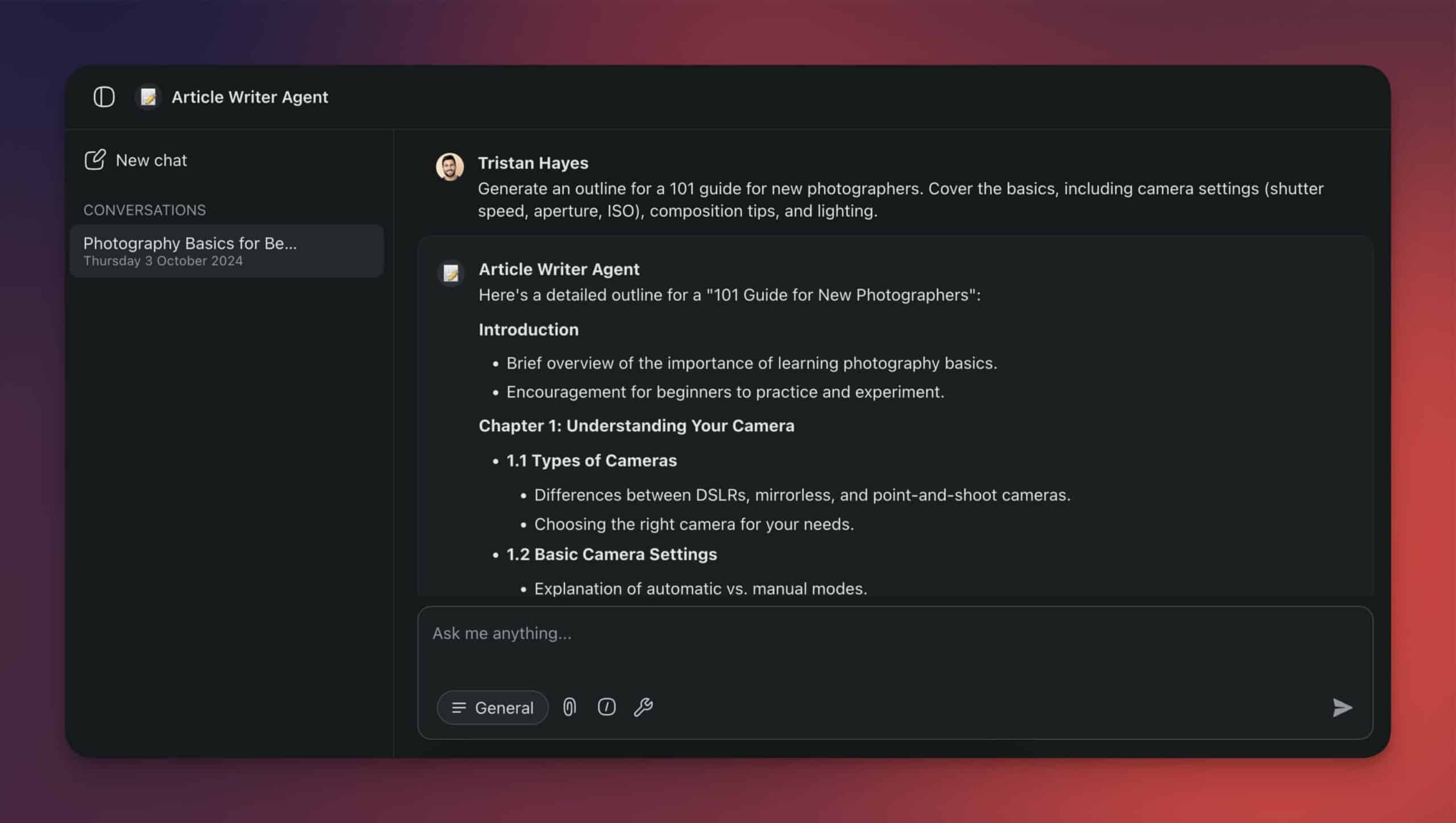
With the outline in place, we can now roll up our sleeves and work on the content.
Instead of asking AI to write the entire thing, tackle it step by step, following the generated outline.
Here’s an example:
⌨️ "Write the introduction for a 101 guide for new photographers. Avoid using technical jargon and make it inviting for beginners."
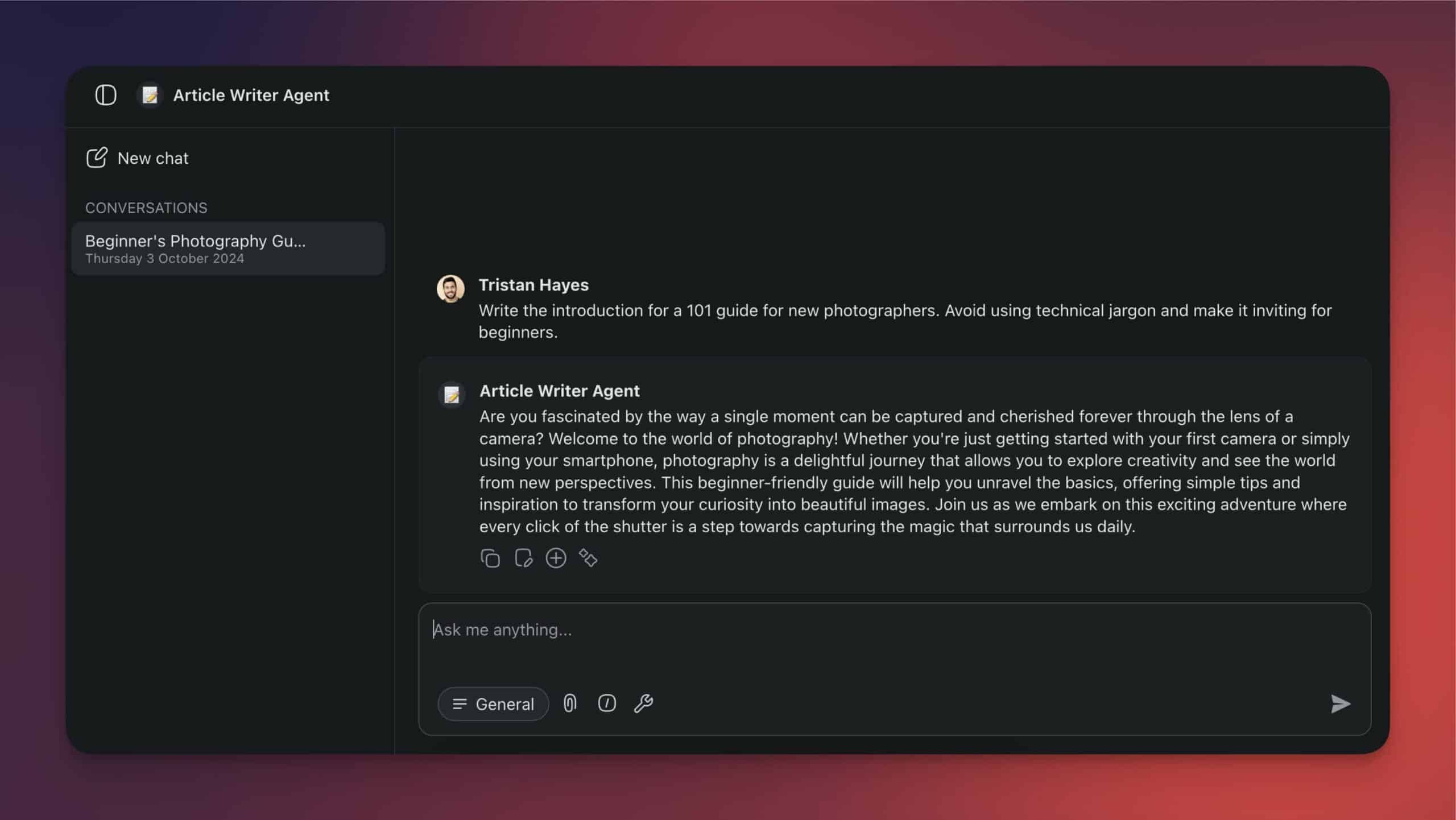
Writing the article step by step gives you more control over the creative process. And if you don’t like what you get, you can easily start over without having to redo the entire thing.
Since we have a general idea who the audience is, let's use the agent to tailor the tone and language to better match our readers. This will make the content more “human.”
Prompt example:
⌨️ "Adjust the tone of the following fragment to be more friendly, encouraging, and easy to understand for new photographers."
And here’s the final result:
🔴 Before:
"Understanding the exposure triangle is imperative for any photographer. It consists of shutter speed, aperture, and ISO. Mastery of these elements allows for optimal exposure in varying lighting conditions."
🟢 After:
"Diving into photography? One of the key concepts to get familiar with is the exposure triangle, which is made up of shutter speed, aperture, and ISO. Think of it as your toolkit to nail the perfect shot, no matter the lighting. Once you get the hang of these elements, you'll be well on your way to capturing beautiful pictures with confidence!"
Still not perfect, but we’re making progress.
🐑 Pro Tip: Don't want to play with prompts? You can customize your agent's tone of voice in the agent menu at any time. Simply go to the Agents tab, select your agent, and click Edit agent. In the General tab, scroll down, and choose one of the options from the Tone drop-down.
Check our Custom AI Agents guide to learn more.
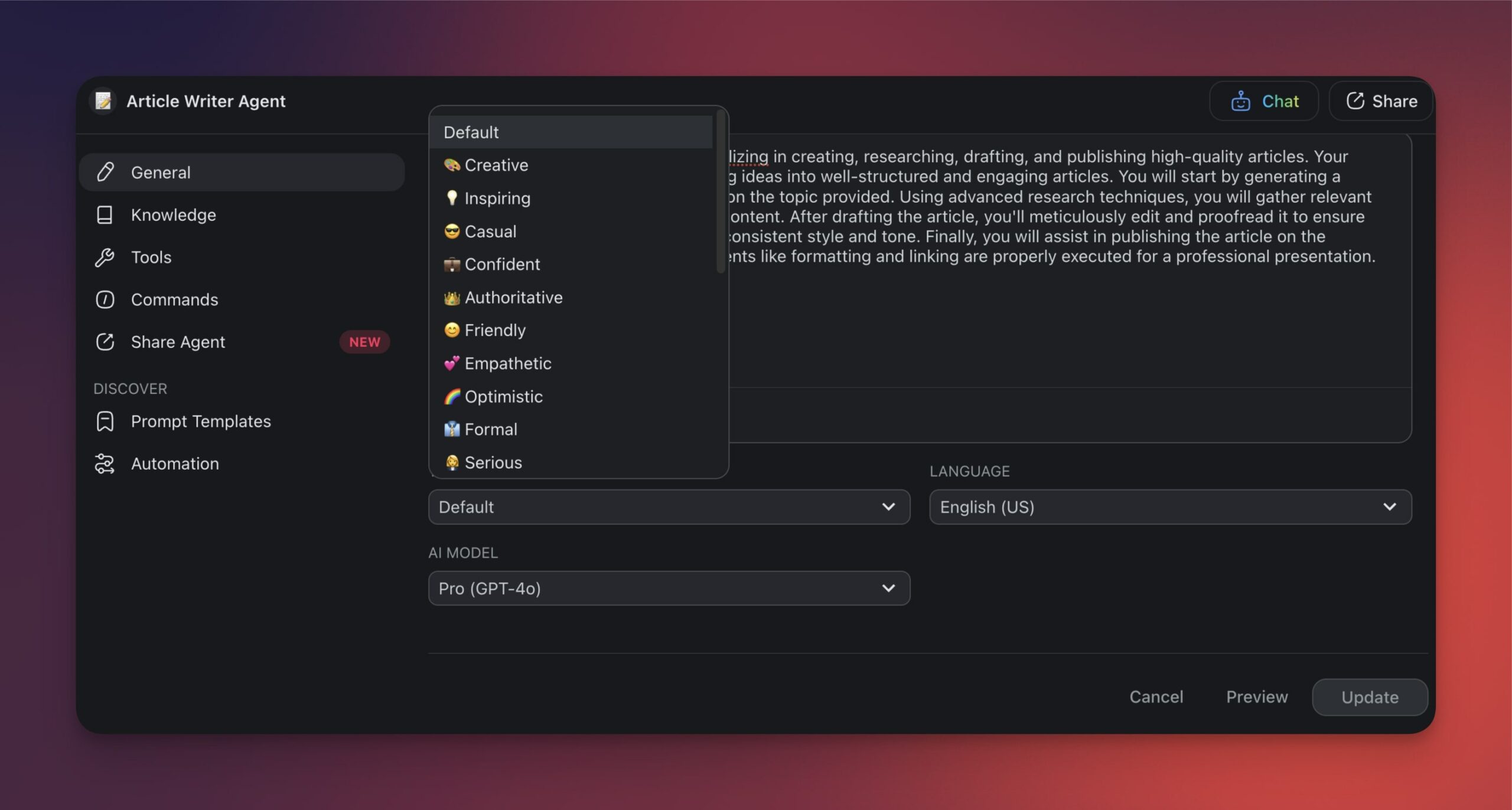
As you can see, we’ve implemented all the steps from the previous section. And we did that in small increments, asking AI for a blueprint and building blocks rather than the finished product.
Now, let’s consider a different example.
Generating Content for an Email Campaign
You're a marketing manager (just pretend for a bit, ok?) working on an email campaign. The goal? Promote a new product called "EcoSip," a sustainable, reusable water bottle with a built-in filter.
(yeah, we know it's not exactly original, but hey, you gotta start somewhere).
Repeat the steps from the previous example to set up a new Email Writer agent to speed things up.
We can now ask the agent to create a blueprint for the email campaign.
⌨️ "Generate an outline for an email campaign to promote a new product called "EcoSip," a sustainable, reusable water bottle with a built-in filter. Include an introductory email, a product benefits email, a customer testimonial email, and a final call-to-action email."
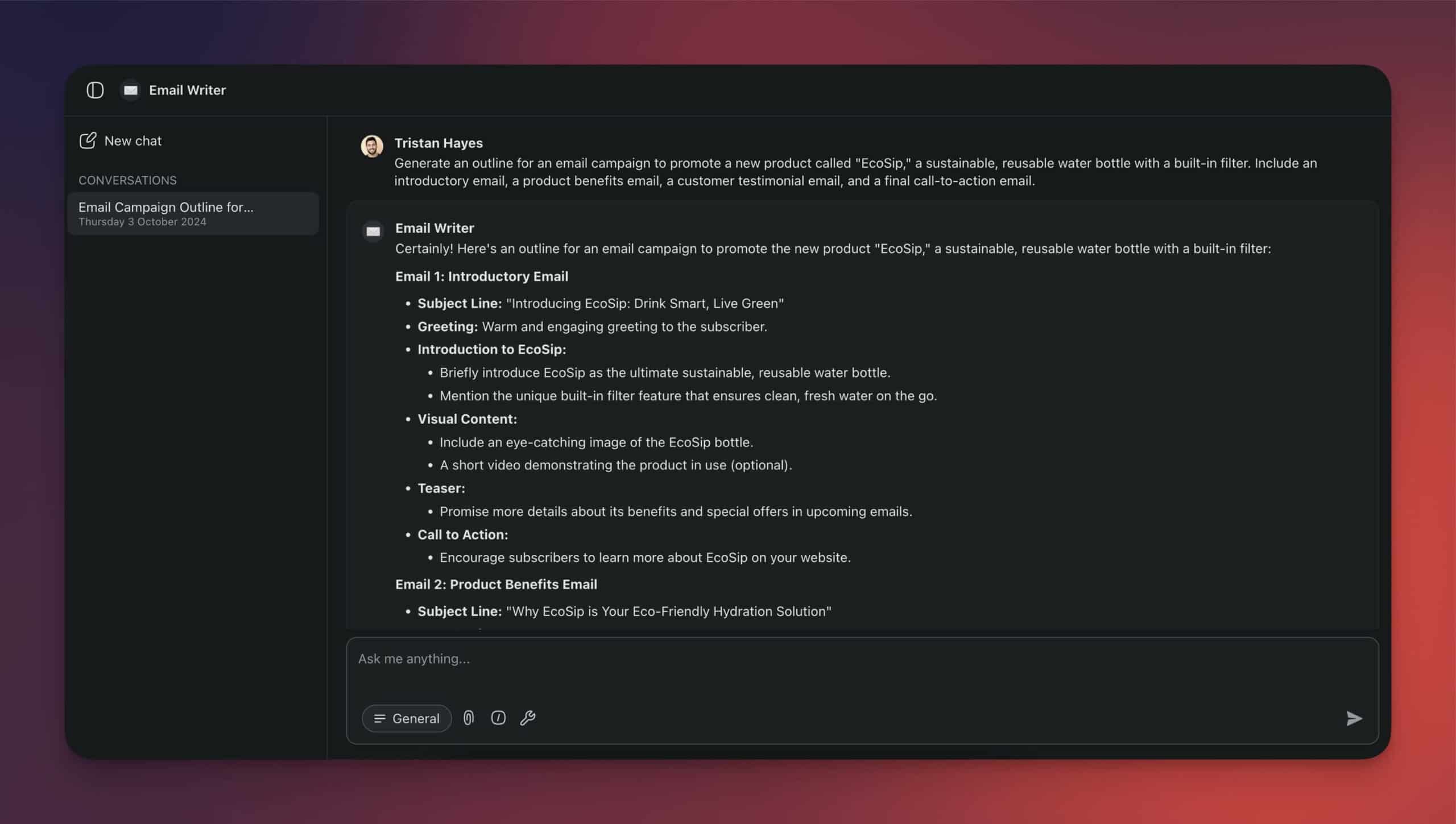
With the outline in place, you can tag team with the agent to develop the campaign in small increments.
Let’s ask the agent to ideate a few subject lines for the emails:
⌨️ "Generate five engaging subject lines for an introductory email for the EcoSip campaign. The subject lines should capture attention, highlight the eco-friendly aspect, and create curiosity about the product."
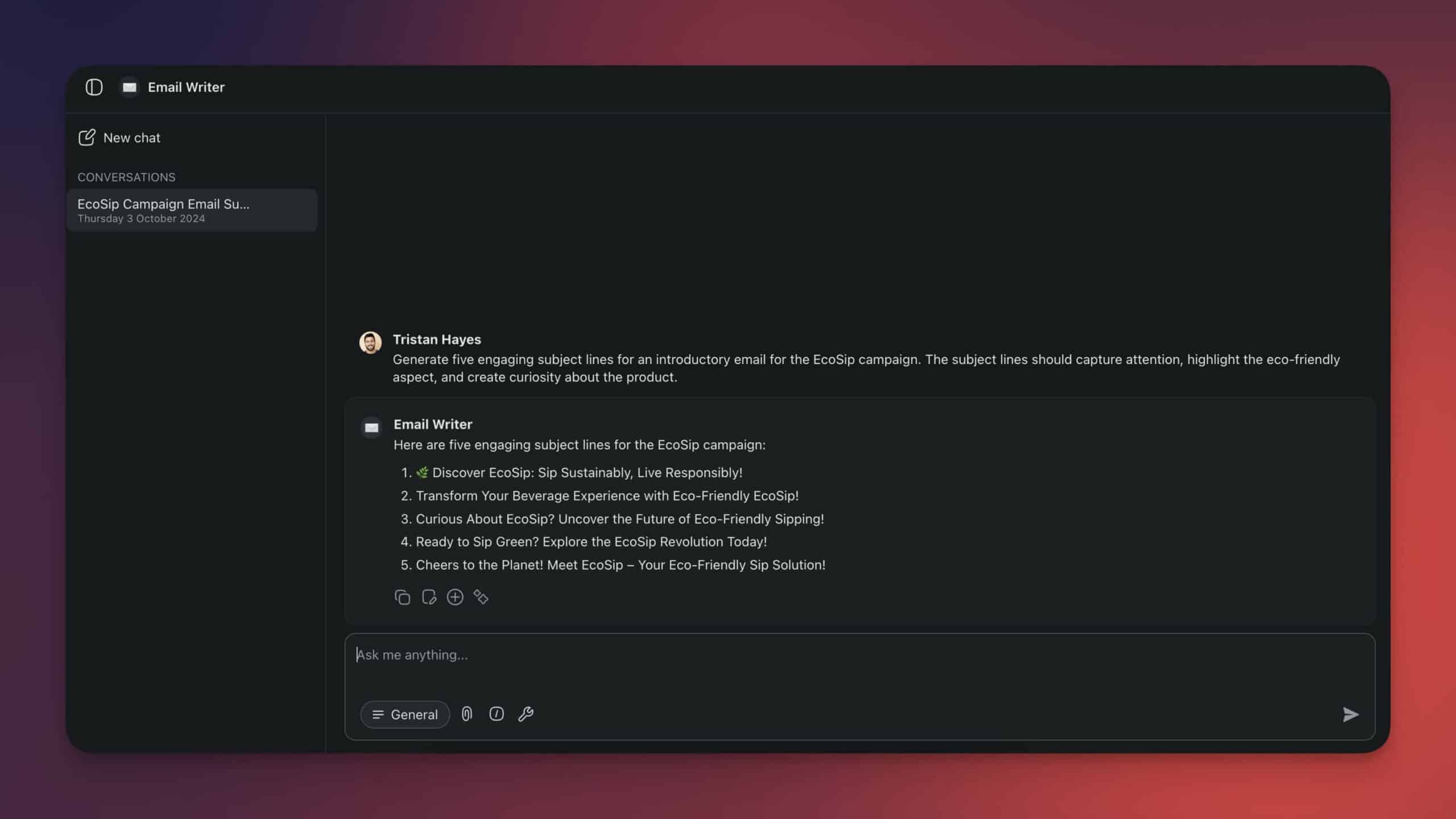
as well as calls to action:
⌨️ "Create five clear and persuasive calls to action for an email promoting EcoSip, the sustainable, reusable water bottle with a built-in filter. The calls to action should encourage the recipient to learn more and purchase the product."
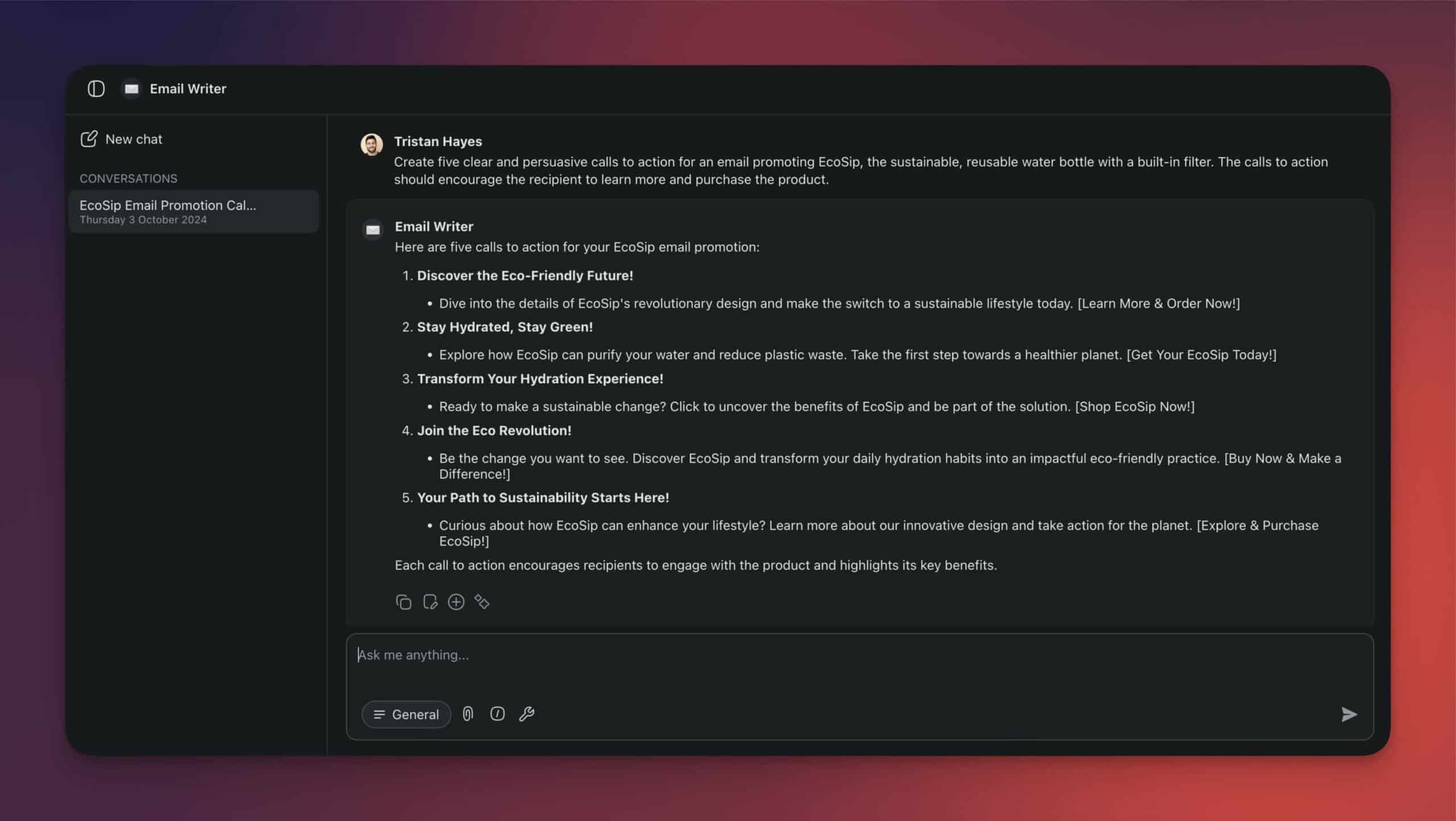
Of course, you still need to refine the copy, but this gives us a great starting point for experimentation.
Once the content is in place, use the agent to implement the tips we've discussed so far.
You can do that by simplifying the language:
⌨️ "Make the product benefits easy to understand for a general audience. Replace complex terms with simple, everyday language."
or tailoring the messaging to the language of your audience:
⌨️ "Use terms that resonate with environmentally conscious consumers. Highlight buzzwords like sustainable and eco-friendly."
🐑 Pro Tip: Retrieval-Augmented Generation (RAG) leverages natural language processing and other AI techniques to allow AI Agents learn in real-time from various sources. For instance, you can upload brand guidelines and resources from past campaigns to improve the relevance of the generated content.
Check our guide to Agent Knowledge & Data to learn more.

Generating Content for Social Media
Social media platforms are peculiar places. They're dynamic, diverse, and offer a unique opportunity to connect with your audience in real-time. But they require a ton of maintenance.
There are a few areas where Taskade AI can help you out.
Any social media posts need good targeting.
Let’s use a new Social Media agent to find the ideal target audience for our content.
⌨️ "Identify the target audience for social media marketing of the EcoSip water bottle. Focus on demographic data such as age, gender, location, interests, and lifestyle preferences."

Once you know who you're talking to, it's easier to create content that resonates.
Now, let’s brainstorm some post ideas:
⌨️ "Generate five engaging ideas for social media posts promoting the EcoSip water bottle. The posts should highlight its eco-friendly features, usability, and innovative design."
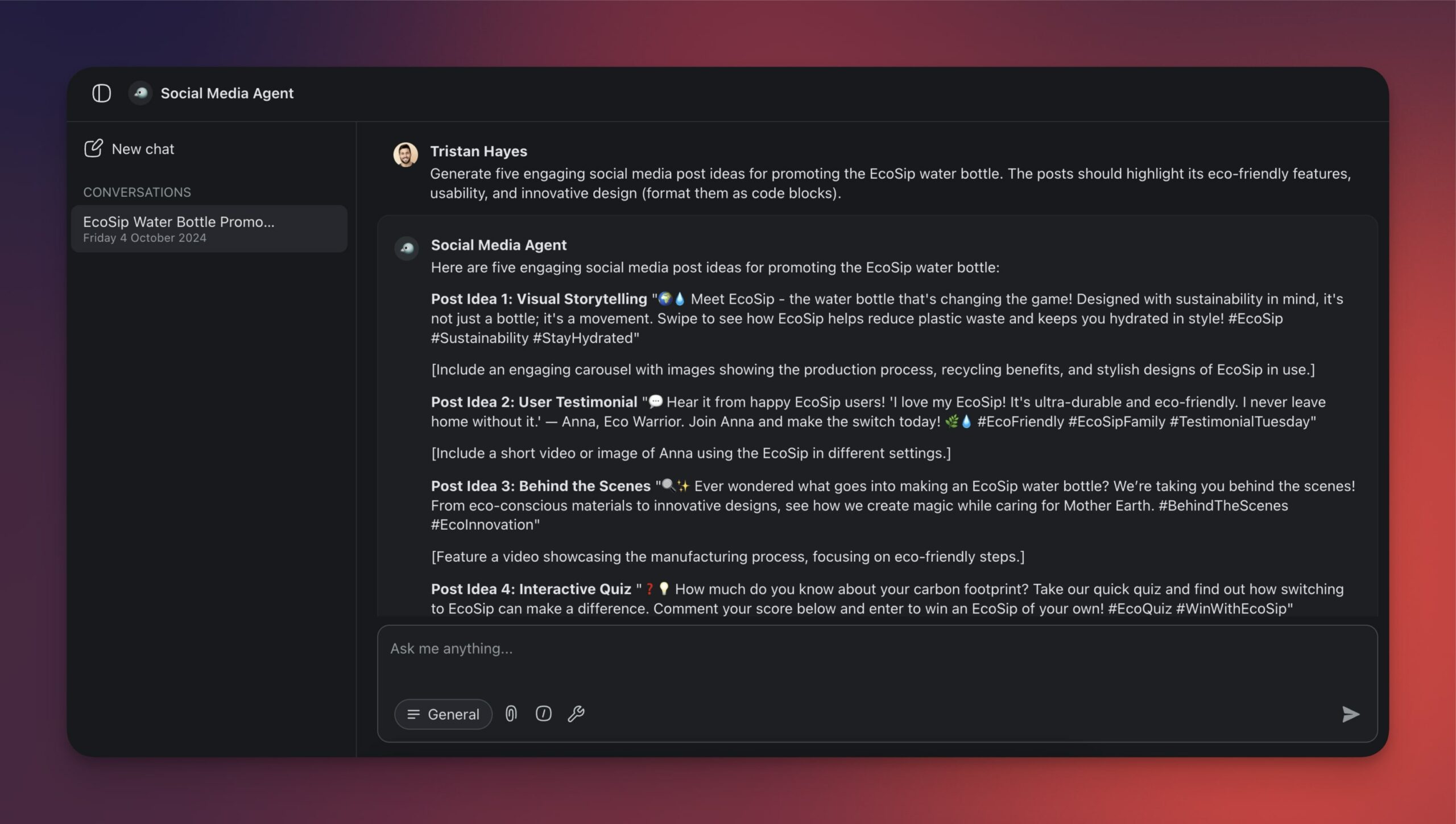
And how about some story concepts?
⌨️ "Create three Instagram Story ideas for promoting the EcoSip water bottle. Focus on interactive elements like polls, quizzes, and user-generated content."
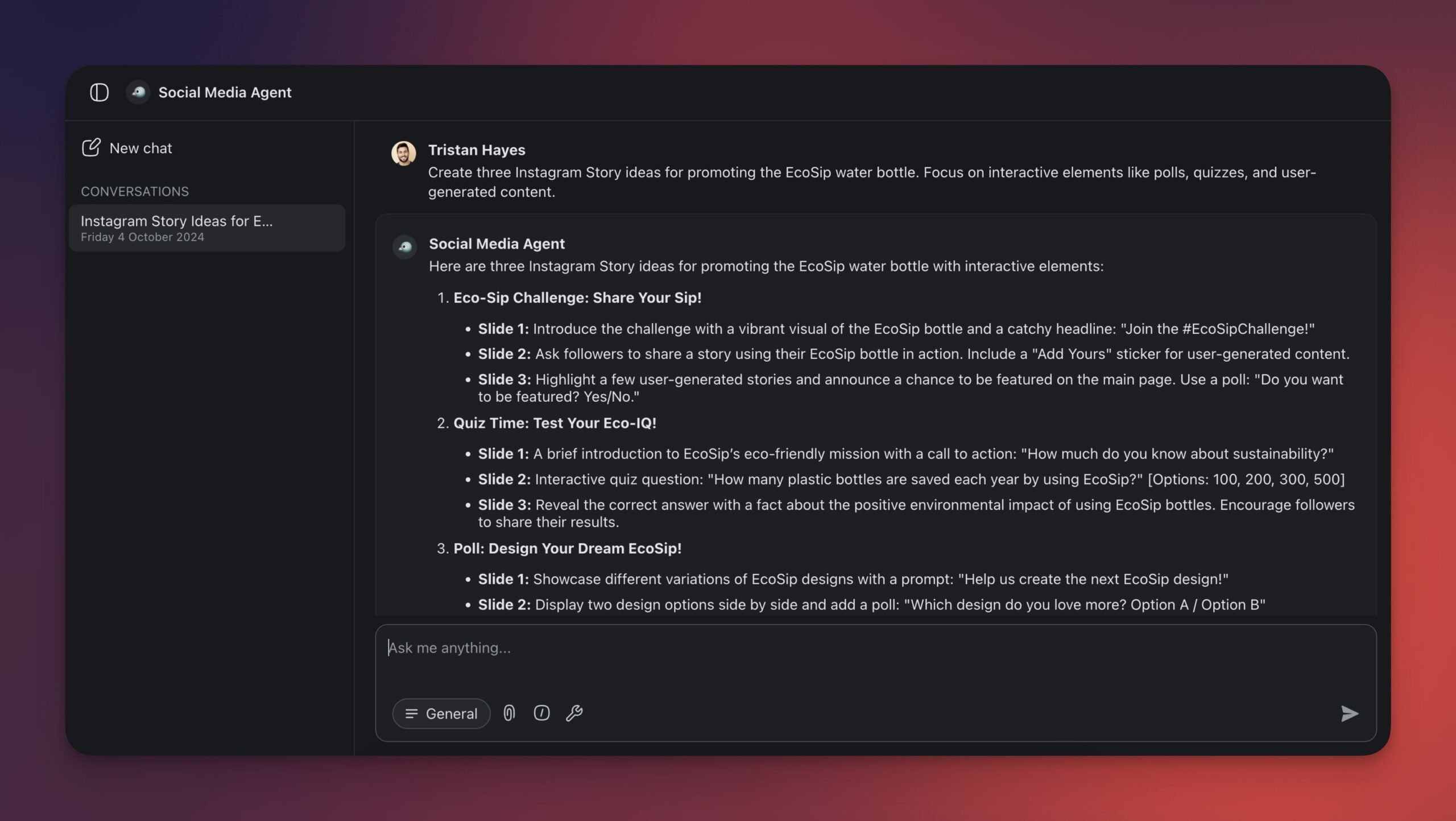
Finally, let’s generate a few hashtags to match:
⌨️ "Generate ten hashtags for promoting the EcoSip water bottle. The hashtags should emphasize its eco-friendly nature, sustainability, and innovative design."
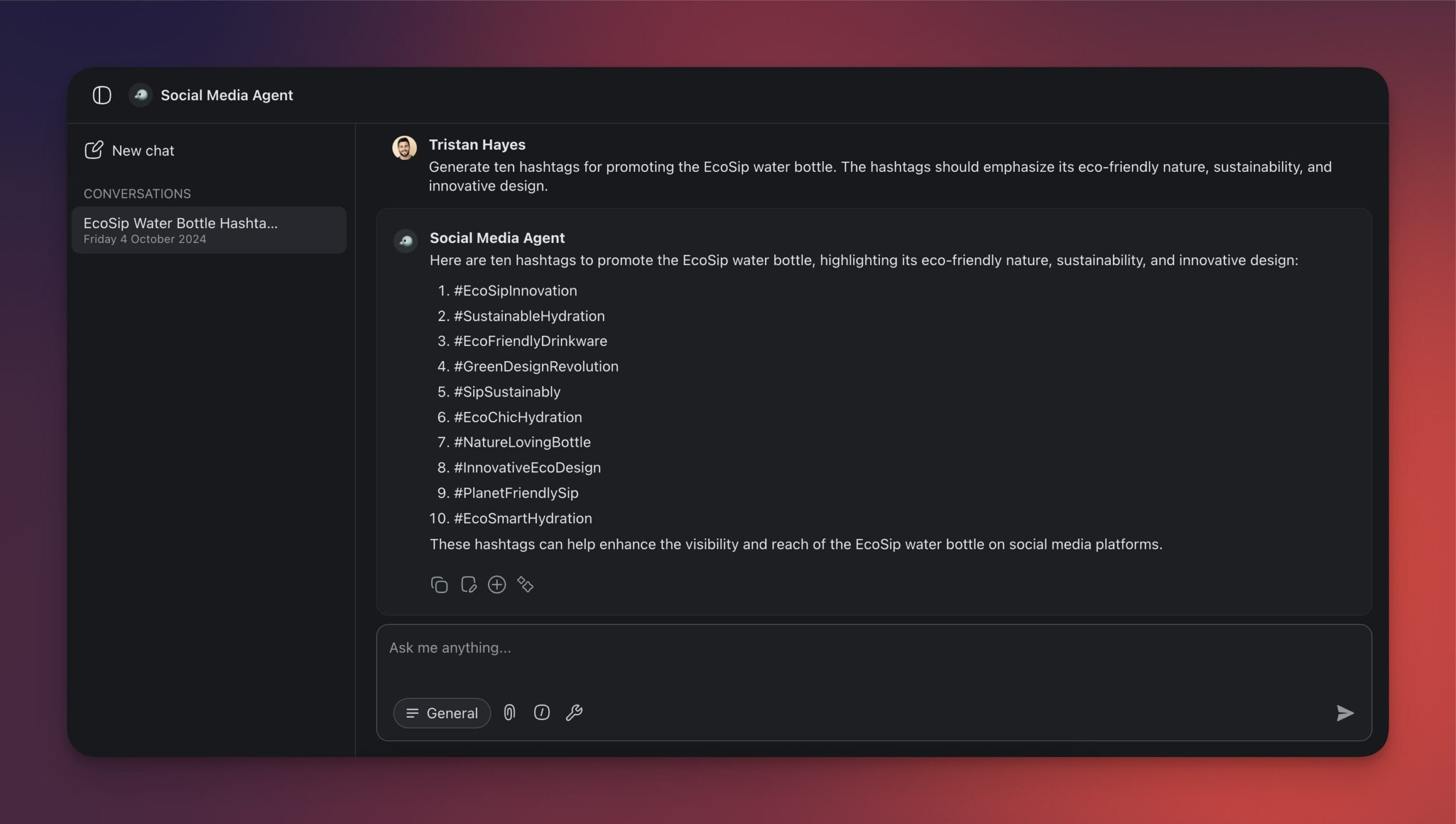
And voilà! A few simple prompts let you cover a range of social media essentials.
🐑 Pro Tip: You can set up automations in Taskade to automatically publish new posts and replies on X. This lets you to focus on crafting quality content while Taskade takes care of the execution.
Check our guide to Taskade Automation to learn more.
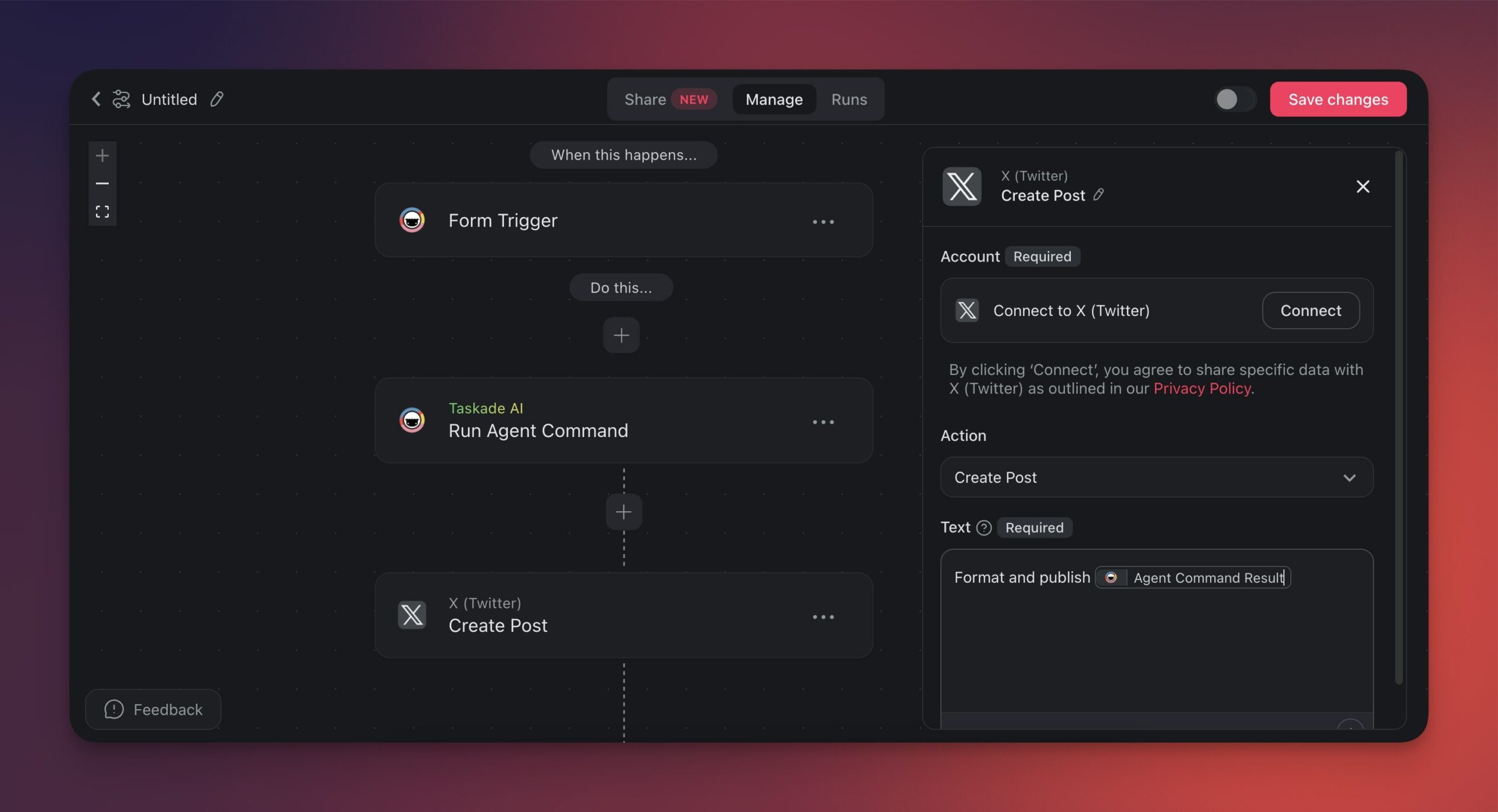
Generating Content for Ebooks or White Papers
Let’s try something different.
Ebooks and whitepapers are fantastic tools for deep dives into a topic. They showcase your expertise and provide value to your audience. If only they weren’t such a nuisance to get from start to finish. 🤷
But don’t worry, you can use an Ebook Writer Agent to streamline the process.
Any content needs structure, and long-form content even more so.
So, let’s kick things off with an outline:
⌨️ "Generate an outline for an ebook on the topic of sustainable living. The ebook should include sections on the environmental impact of daily habits, easy swaps for a greener lifestyle, and long-term benefits of sustainable living."
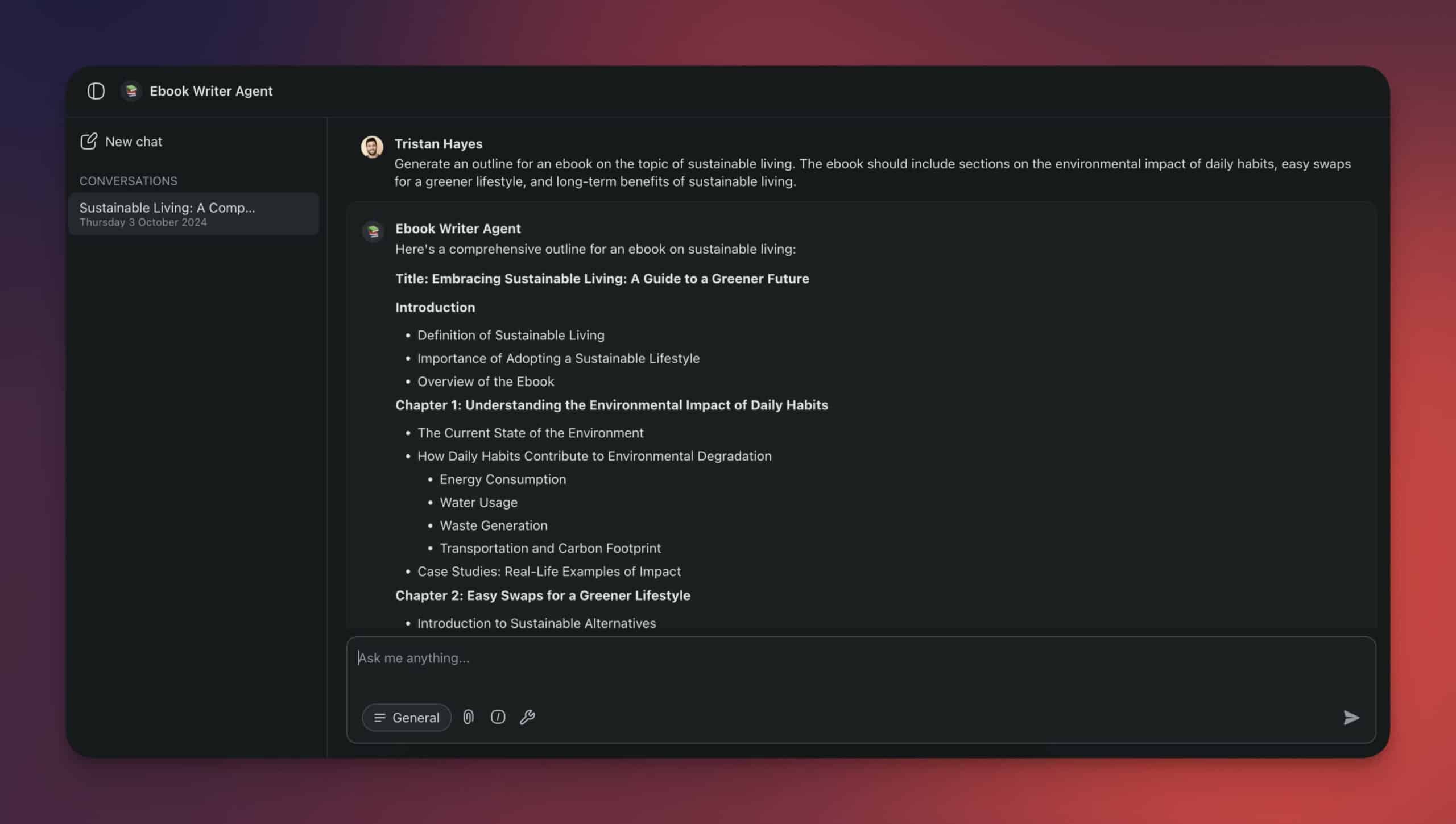
To add more depth, we might include some statistics and real-life examples.
The agent can run a web search and aggregate the latest stats for you:
⌨️ "Provide five statistics on the environmental impact of plastic usage; include the sources."
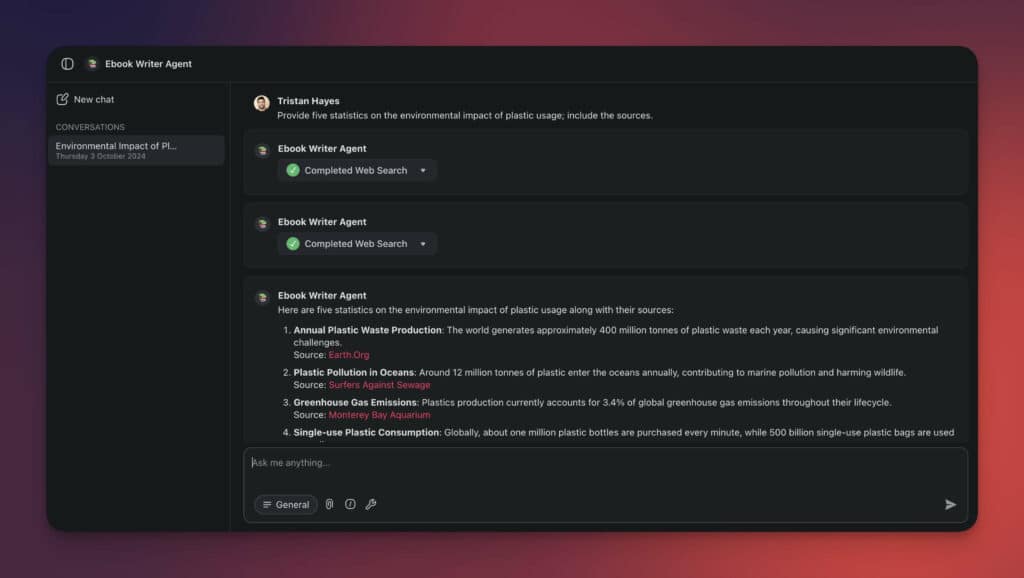
It can also conjure up templates for real-life examples or case studies:
⌨️ "Provide ideas and templates for real-life examples or case studies of individuals or communities successfully adopting sustainable living practices. Include key actions taken and the impact."
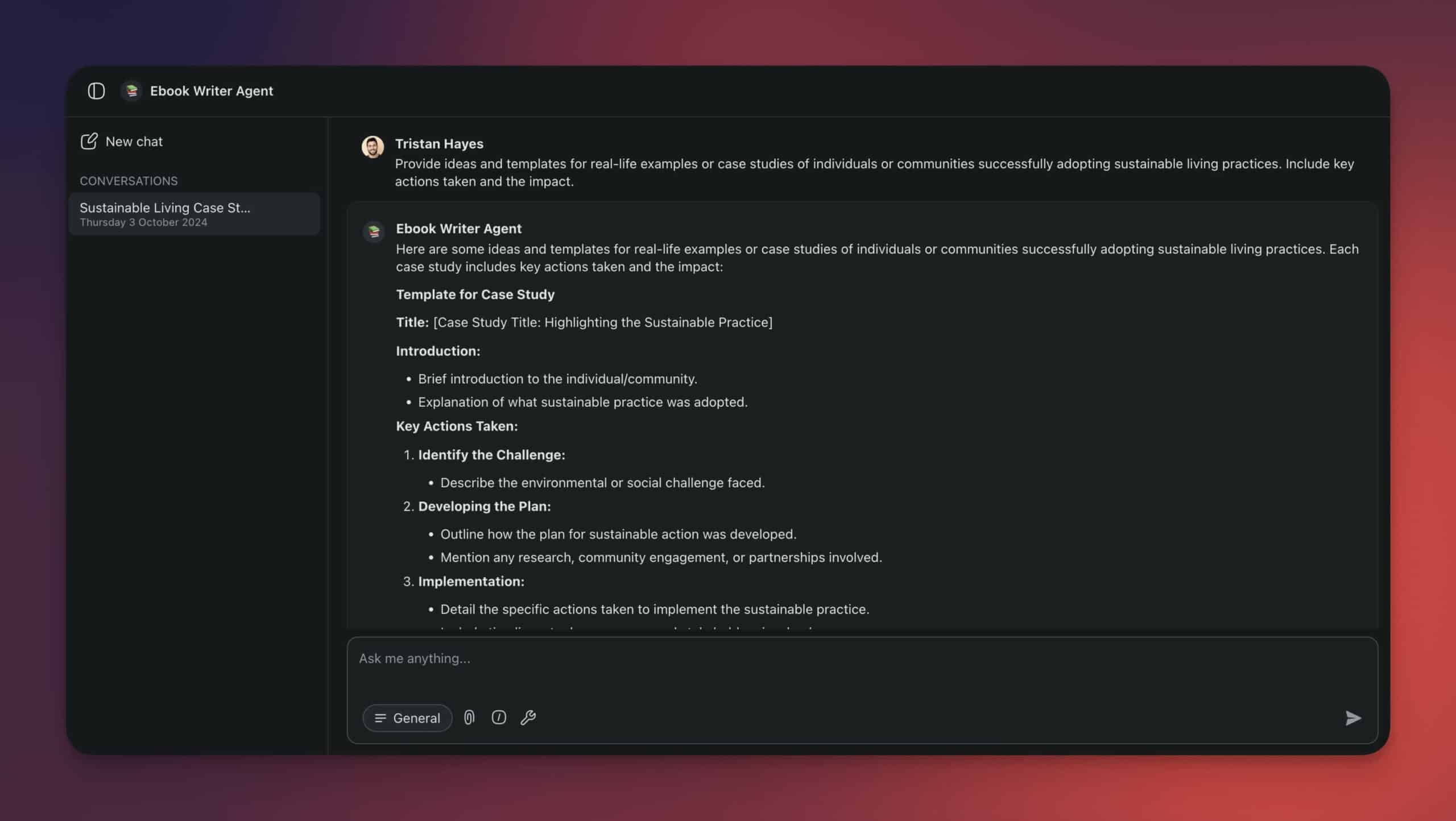
You can also ask for help with the visual side of your content strategy:
⌨️ "Suggest a design for an ebook on sustainable living. Ideas for images, graphics, and formatting."
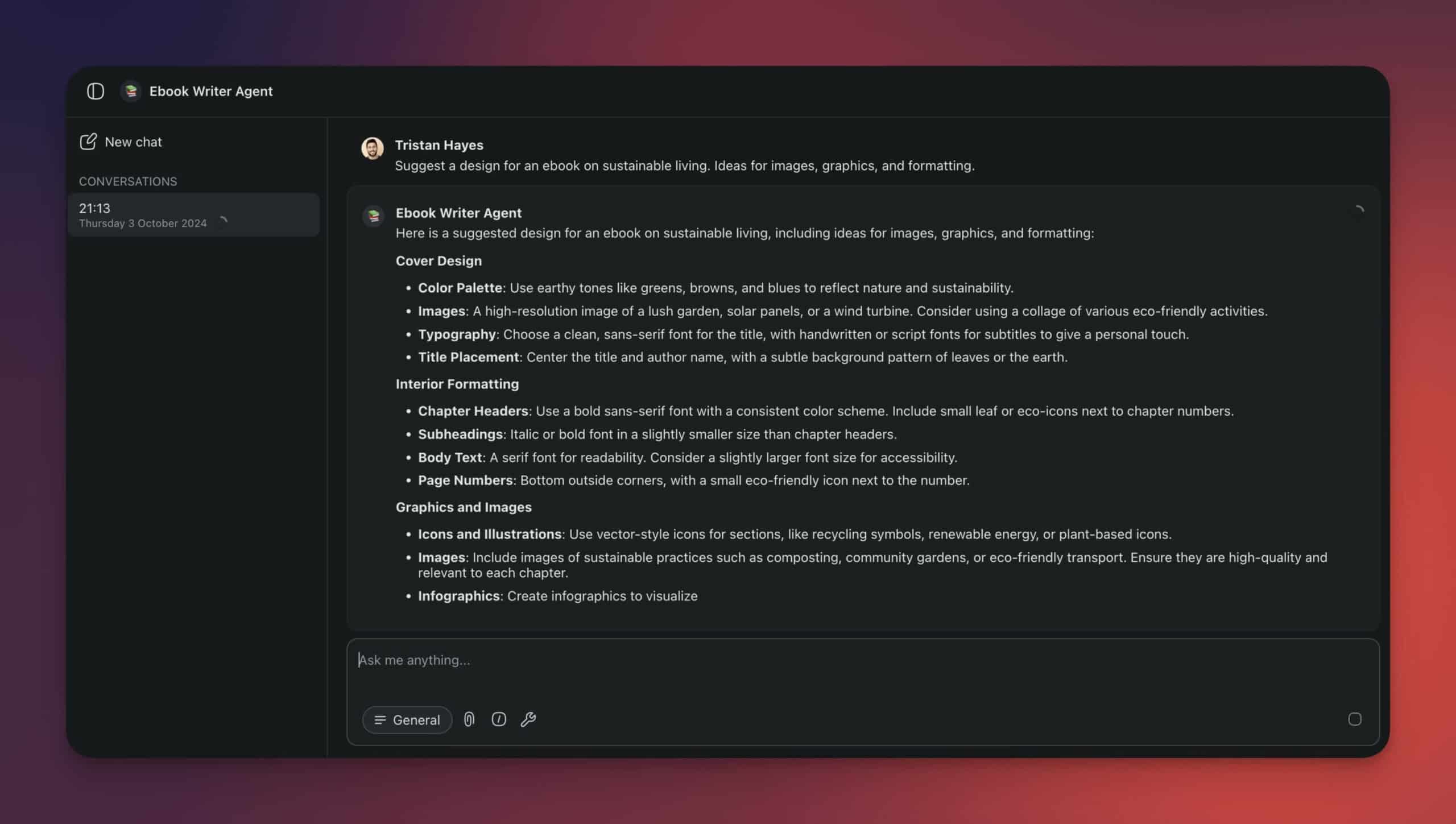
Next, tackle the content chunk by chunk, like we did in the previous examples.
Tap the agent for engaging and captivating intros:
⌨️ "Write an engaging introduction for an ebook on sustainable living. Make it inviting and highlight the importance of the topic for a general audience."
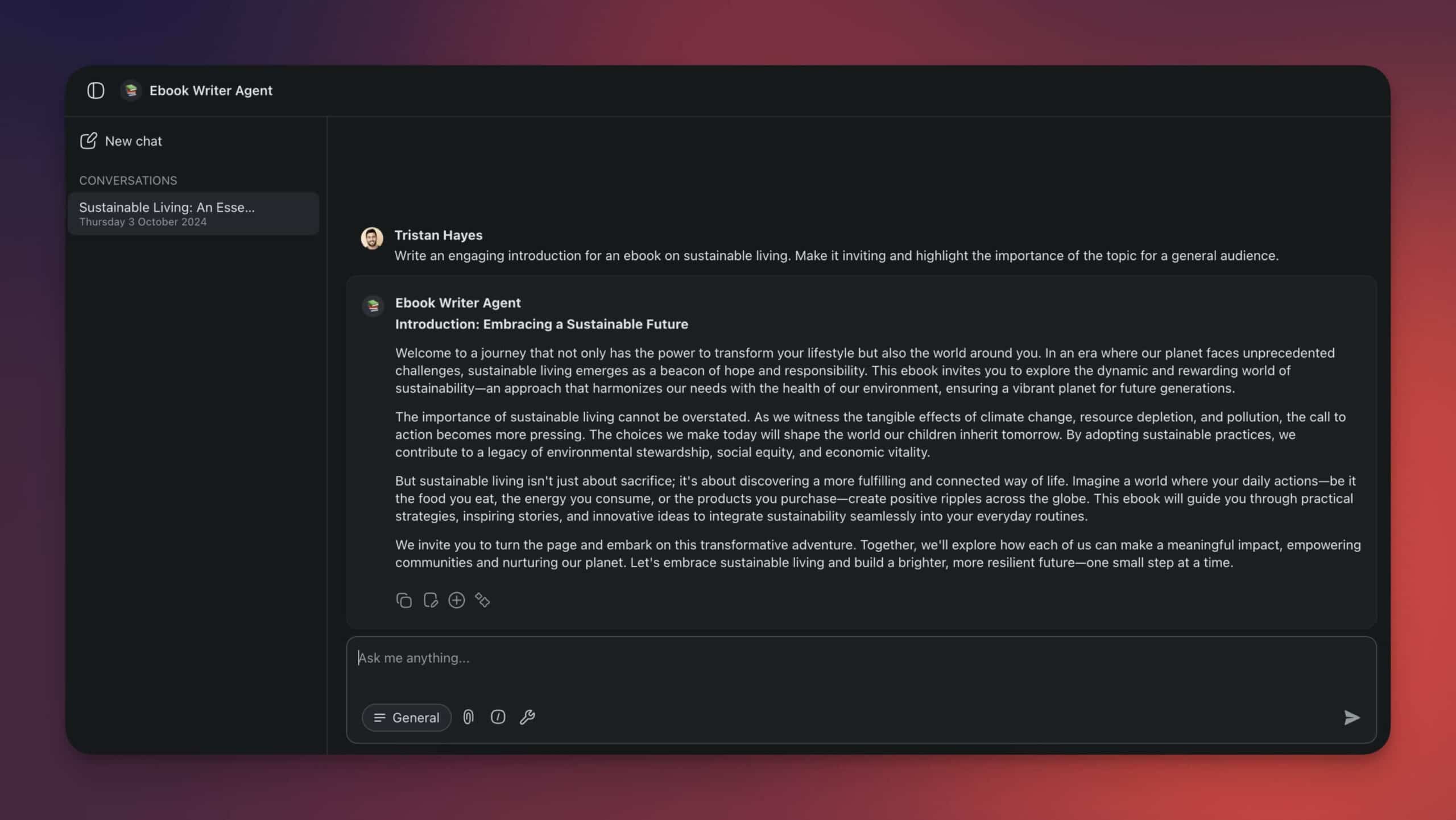
Ask it to come up with detailed solutions to common problems:
⌨️ "Write a section on practical swaps for a greener lifestyle. Include tips on reducing plastic use, conserving energy, and sustainable shopping. Appeal to common pain points."
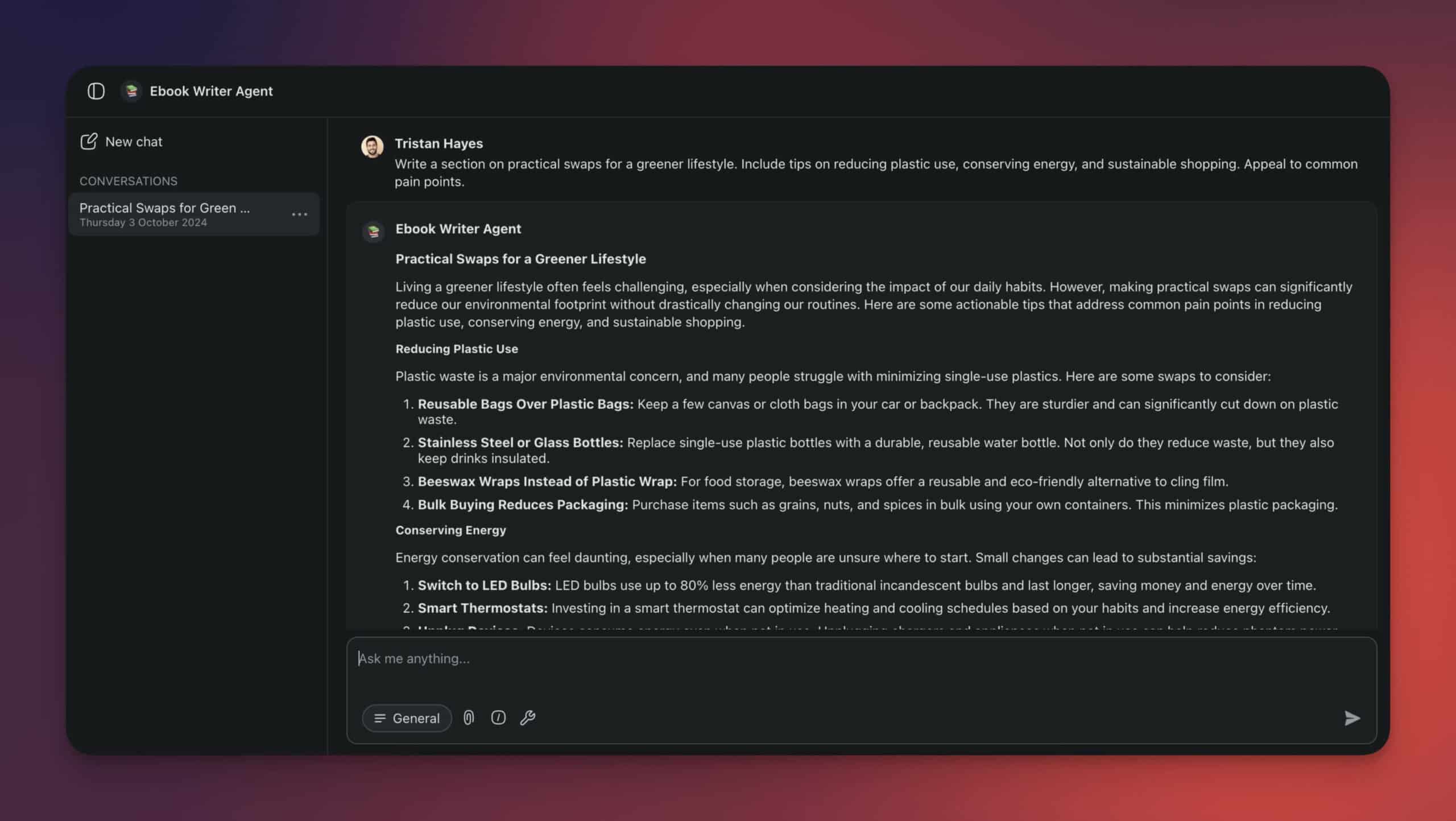
or to reiterate key points and summarize benefits to drive your message home:
⌨️ "Summarize the long-term benefits of sustainable living. Highlight both environmental and personal health benefits. Emphasize the reduction in pollution, conservation of resources, and improved well-being (10 items each; formatted as a table)."
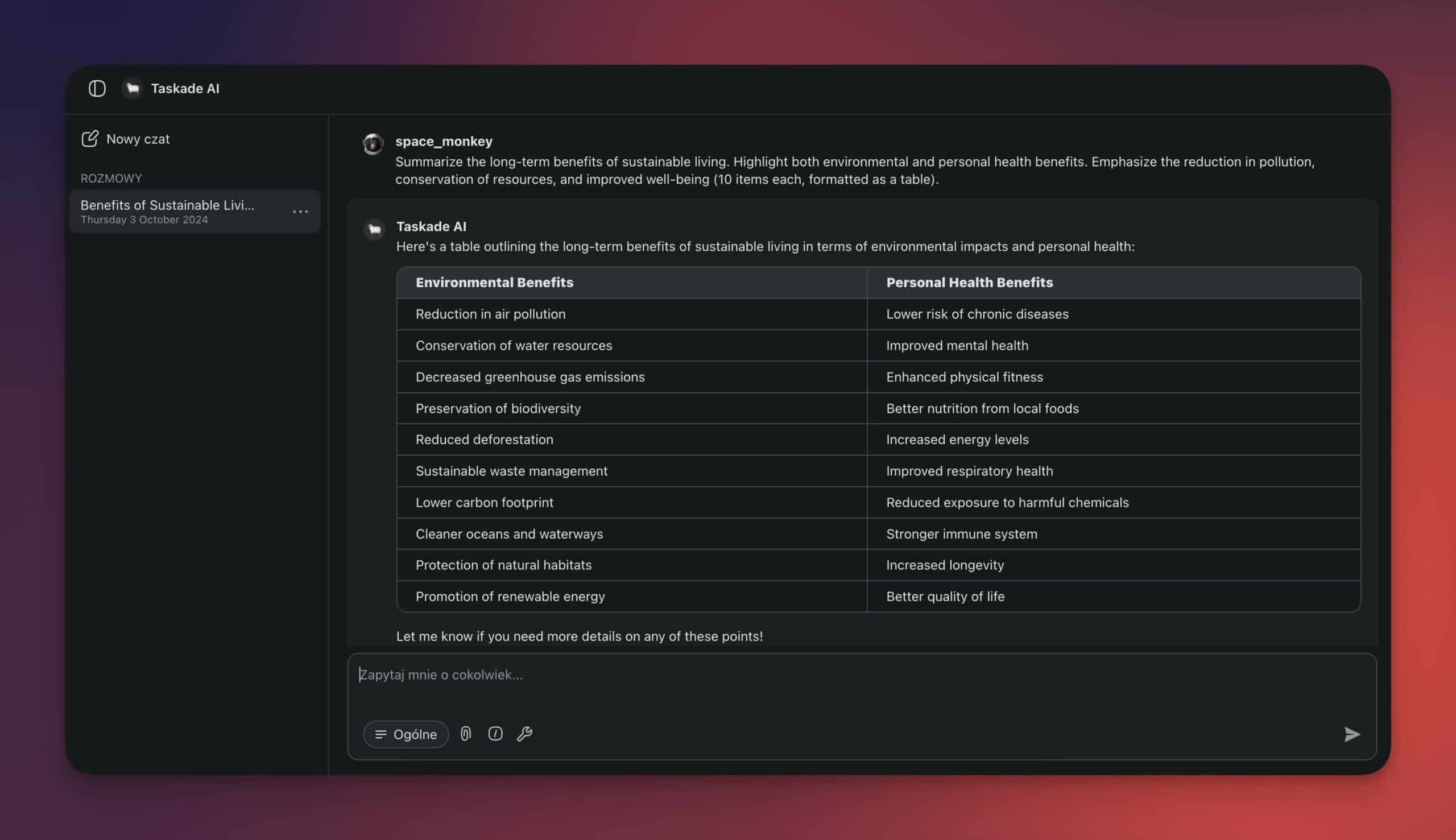
Leather, rinse, repeat until you have all the essential elements in place.

👀 Reviewing and Editing AI-Generated Content
You now have everything you need to get started. But before you prompt away, there is something we need to discuss. Ok, there are a few more things, so bear with us.
Check for AI Hallucinations
AI is powerful, but it isn’t infallible. Sometimes, it just makes stuff up or mixes reality with fiction in ingenious ways; and it won’t even tell you it’s done so. This phenomenon is called “AI hallucinations.”
Always cross-check any factual information or statistics the AI has provided. Verify sources and ensure everything is accurate. Don’t let a rogue factoid tarnish your credibility.
👀 What to look out for:
✅ Incorrect or fabricated statistics
✅ Misattributed quotes or sources
✅ Inconsistent factual information
✅ References to non-existent sources
✅ Unrealistic claims or hyperbole
Tone and Style Consistency
Even after adjusting the tone to suit your audience, double-check for consistency throughout the document. AI can sometimes slip back into a robotic or inconsistent tone mid-way.
The rule of thumb? Make sure the piece flows naturally. You know, like it was written by a single human with a coherent voice. If you spot any sections that feel off, tweak them for consistency.
👀 What to look out for:
✅ Unexpected shifts in tone or style
✅ Robotic or unnatural phrasing
✅ Inconsistent voice throughout the document
✅ Overly formal or too casual segments
✅ Sentences that feel out of place or jarring
Eliminate Redundancies
One common issue with AI-generated content is redundancy. The AI might repeat the same points in slightly different ways. Sometimes, it sneaks in extra phrases or filler content that doesn't add value.
Don’t let your content sound like a broken record — keep it sharp and to the point. Scan through your document and eliminate any repetitive sentences or paragraphs. Your readers will thank you for it.
👀 What to look out for:
✅ Repeated ideas or phrases
✅ Unnecessary filler sentences
✅ Overly verbose explanations
✅ Reiteration of the same points in different words
✅ Sections that don’t add new information
Inject Personality
AI-generated content can sometimes feel a bit sterile. At a glance, it seems okay, but you feel that nagging sensation that something's off. It’s missing that human touch, that spark of individuality.
Don’t be afraid to inject your personality into the final product. Add anecdotes, humor, or a bit of edge; make it sound like you. Let your quirks shine through and give your audience something real.
👀 What to look out for:
✅ Bland or generic language
✅ Lack of personal anecdotes or humor
✅ Overly formal or stiff tone
✅ Absence of personal opinions or insights
✅ Generic, one-size-fits-all advice
And there you have it!
👋 Parting Words
Contrary to the nay-sayers, doom-sayers, and other skeptics, AI isn't here to replace you. Ok, it isn’t here to replace you just yet (just kidding... or are we?). But it can make your life easier.
So, use it smartly, and you'll crush it.
Before you go, let’s recap the key takeaways from this article:
⭐ Know what the hell you want to create. Stay on top of your content strategy.
⭐ AI can hallucinate. Trust, but verify every damn fact.
⭐ Be specific. Vague prompts equal vague results.
⭐ Improve content quality with AI to save time, but...
⭐ Don’t be a robot. Add your quirks and make it real.
⭐ AI isn’t perfect. Verify sources to keep your content legit.
⭐ Keep it coherent. No one likes a split personality in writing.
⭐ Use AI content creation tools to supplement human-created content.
⭐ Trim the fat. No one has time for fluff.
⭐ AI can’t replicate your unique voice.
⭐ First draft’s never perfect. Invest time in AI content optimization.
⭐ AI isn’t replacing you — yet. Use it wisely, and you’ll dominate.
Ready to elevate your content game?
Build your team of custom AI Agents today! 🚀
🤖 Custom AI Agents: Build smart, autonomous AI agents to get all the help you need 24/7.
👥 AI Teams: Group your AI agents into specialized teams based on their expertise.
⚡️ Smart Automations: Set up powerful automations with ready-made blocks.
🪐 One App to Rule Them All: Manage all your tasks, projects, and AI writing tools in one place.
And much more...
